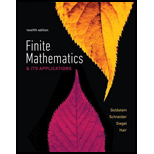
Concept explainers
(a)
To graph: The transition diagram for Markov process, if some colleges have been rapidly making broadband internet services available in their residence halls of the colleges that offer no broadband internet service, where each year 10% FIOS internet service are introduce, 30% cable internet services are introduce and 60% continue to offer no broadband service, if a broadband service established then it can never be change.
(b)
The absorbing stochastic matrix for the Markov process, if some colleges have been rapidly making broadband internet services available in their residence halls of the colleges that offer no broadband internet service, where each year 10% FIOS internet service are introduce, 30% cable internet services are introduce and 60% continue to offer no broadband service, if a broadband service established then it can never be change.
(c)
To calculate: The stable matrix, if some colleges have been rapidly making broadband internet services available in their residence halls of the colleges that offer no broadband internet service, where each year 10% FIOS internet service are introduce, 30% cable internet services are introduce and 60% continue to offer no broadband service, if a broadband service established then it can never be change.
(d)
To calculate: The percent of collages provide cable internet service for long run, if some colleges have been rapidly making broadband internet services available in their residence halls of the colleges that offer no broadband internet service, where each year 10% FIOS internet service are introduce, 30% cable internet services are introduce and 60% continue to offer no broadband service, if a broadband service established then it can never be change.
(e)
To calculate: The expected number of years required for a college to set up a broadband service when there is no broadband service provided currently, if some colleges have been rapidly making broadband internet services available in their residence halls of the colleges that offer no broadband internet service, where each year 10% FIOS internet service are introduce, 30% cable internet services are introduce and 60% continue to offer no broadband service, if a broadband service established then it can never be change.
Want to see the full answer?
Check out a sample textbook solution
Chapter 8 Solutions
Finite Mathematics & Its Applications (12th Edition)
- Using Karnaugh maps and Gray coding, reduce the following circuit represented as a table and write the final circuit in simplest form (first in terms of number of gates then in terms of fan-in of those gates). HINT: Pay closeattention to both the 1’s and the 0’s of the function.arrow_forwardRecall the RSA encryption/decryption system. The following questions are based on RSA. Suppose n (=15) is the product of the two prime numbers 3 and 5.1. Find an encryption key e for for the pair (e, n)2. Find a decryption key d for for the pair (d, n)3. Given the plaintext message x = 3, find the ciphertext y = x^(e) (where x^e is the message x encoded with encryption key e)4. Given the ciphertext message y (which you found in previous part), Show that the original message x = 3 can be recovered using (d, n)arrow_forwardTheorem 1: A number n ∈ N is divisible by 3 if and only if when n is writtenin base 10 the sum of its digits is divisible by 3. As an example, 132 is divisible by 3 and 1 + 3 + 2 is divisible by 3.1. Prove Theorem 1 2. Using Theorem 1 construct an NFA over the alphabet Σ = {0, 1, 2, 3, 4, 5, 6, 7, 8, 9}which recognizes the language {w ∈ Σ^(∗)| w = 3k, k ∈ N}.arrow_forward
 Elementary Linear Algebra (MindTap Course List)AlgebraISBN:9781305658004Author:Ron LarsonPublisher:Cengage Learning
Elementary Linear Algebra (MindTap Course List)AlgebraISBN:9781305658004Author:Ron LarsonPublisher:Cengage Learning
